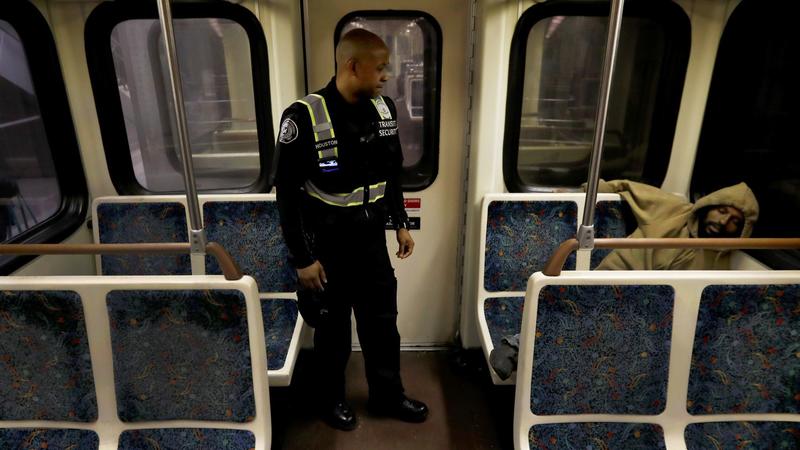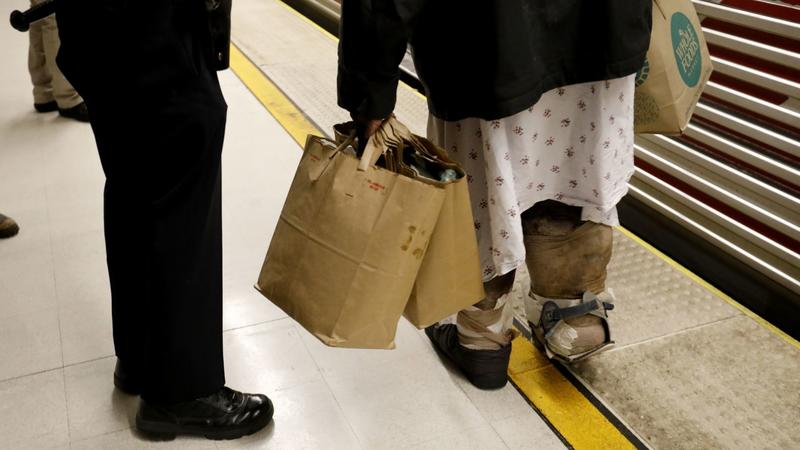
Share On Social!
Although violent crimes on the Los Angeles County (48.6% Latino) Metropolitan Transit Authority (Metro) are rare, riders complain the high number homeless individuals makes them feel unsafe.
In a 2016 survey, 29% of former riders told Metro they stopped taking transit because they felt unsafe, according to the Los Angeles Times. The next year, Metro increased spending on law enforcement and security by 37%.
However, police presence alone is not enough to address perceptions of safety.
“We cannot and should not arrest our way out of the problem,” said Jennifer Loew, Metro’s director of special projects.
That’s why Metro paired law enforcement officers with social workers as part of their homeless outreach program.
Transit Agencies and Homelessness
Transit systems provide basic needs, such as shelter and restrooms, to individuals experiencing homelessness. Still, they are often protected by police.

However, in places with large homeless populations like Los Angeles County, sanitation and safety concerns are at crisis levels — impacting ridership.
“We are seeing evidence of homelessness throughout our entire system,” Alex Wiggins, Metro’s chief system security and law enforcement officer, told the Los Angeles Daily News.
Homelessness is thought to negatively impact ridership.
Nationally, more than three in four transit agencies surveyed said that homelessness impacts ridership, according to a 2018 American Public Transportation Association (APTA) report, “Public Transit and Social Responsibility: Homelessness.”
The APTA Leadership team also found that 68% believed transit agencies should play a role in addressing homelessness.
Wiggins knew that individuals experiencing homelessness often also experience mental illness and substance use disorder and thought Metro could do more to support these individuals while ensuring the safety of Metro passengers.
Homelessness in LA
Nearly 58,000 people were experiencing homelessness in Los Angeles County — a 26% increase from 2016, according to the Los Angeles Daily News.
Voters were concerned and took major action in 2016 and 2017.
In November 2016, voters approved Measure HHH: A $1.2 billion bond measure to help construct 10,000 affordable housing unit.
Moreover, In March 2017, voters approved Measure H: A sales tax increase expected to raise $355 million annually to implement a list of strategies for combatting homelessness.
Both the County and City of Los Angeles (48.7% Latino) prioritized comprehensive and coordinated outreach services.
However, Metro wouldn’t receive any funding.
Metro’s Homeless Outreach Program
In October 2016, Metro launched their Homeless Task Force to develop a comprehensive strategy to better connect individuals experiencing homelessness in and around Metro’s transit system to housing and support services.
The task force collected information on homeless individuals encountered on the Metro to better understand their needs. They also studied what other transit agencies from other regions are doing about homelessness.

Metro’s board approved $1.2 million to pilot the deployment of two multidisciplinary homeless outreach teams dedicated exclusively to the Metro system. The teams included a medical professional, social worker, former homeless person, advocate, and supervisor.
The outreach team connected individuals experiencing homelessness to resources and services. These could include enrolling people in Medicaid, signing them up for food stamps, or trying to connect them with housing.
In March 2017, Metro released their Transit Homeless Action Plan with a focus on research, education, coordination, and outreach.
In July 2017, Metro amended its law enforcement structure, which allows for the deployment of specifically trained officers to engage patrons with mental illness and/or homelessness.
Now, Metro funds 40 social workers in teams of five and 22 law enforcement officers specifically to address homelessness.
As of March, Metro teams have engaged with 2,658 homeless individuals. Of those:
- 1,942 were provided services or successful referral
- 88 were permanently housed
- 307 were linked to permanent housing resource
- 742 were linked to an interim housing resource
In May, Metro’s contract with the L.A. County Department of Health Services was extended for two year.
Public Transit and Social Responsibility: Homelessness
Even without dedicated funding, transit agencies can take action to support individuals experiencing homelessness.
The 2018 APTA Leadership Project team developed a Call to Action with five strategies for transit agencies across the country:
- Transit providers must treat all individuals with dignity and respect. Remember, that transit is a good for the entire community including homeless individuals.
- Incorporate outreach officers with law enforcement to connect individuals to services. This is something that can be started on a small scale with the addition of one or two outreach officers targeted at locations that are known locations where homeless individuals congregate.
- Align transit service with social service destinations. Depending on locations of those services, consider operating a fare-free route.
- Partner with local municipalities and the private sector to identify funding opportunities. There may be opportunities for funding that are not typically considered for transit service if they are sought out in partnership with social service organizations.
- Develop creative solutions that do not require funding such as hiring a homeless individual for an entry level position. These positions could even be stationed at facilities to provide attended restrooms or elevators.
Beyond transit police as community partners, transit agencies play a role in preventing homeless. Access to reliable transportation increases mobility, which is a big factor in economic mobility and determining whether someone will escape poverty and avoid homelessness.
Do you know how the transit agency in your community is supporting individuals experiencing homelessness?
Share what Metro in Los Angeles is doing along with the Leadership APTA report.
By The Numbers
56.9
percent
of Latinos are "housing cost burdened"



